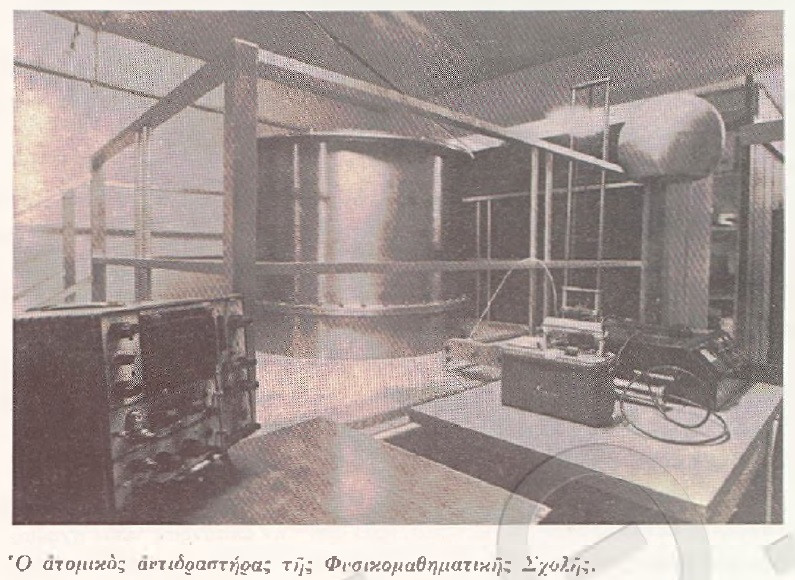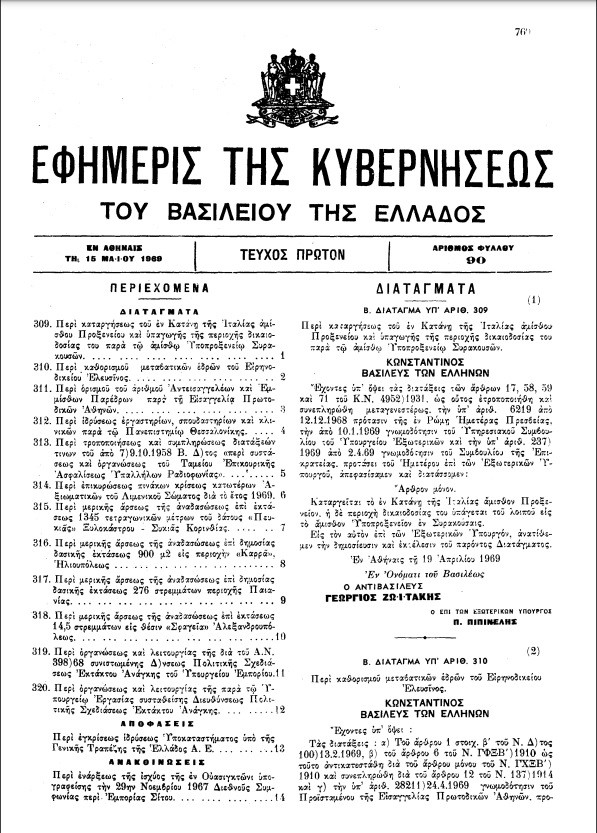What does it mean that the AUTH reactor is “subcritical”? The Laboratory of Atomic and Nuclear Physics of AUTH – “There is no danger of the type that people imagine”
“The subcritical reactor of the Laboratory of Atomic and Nuclear Physics of the University of Thessaloniki is manufactured by the Nuclear Chicago Corporation. It is an open tank with a common, desalinated water retarder. The fissile material is 2,494 kg of natural uranium, in rods – cartridges of about two kilograms each.” Professor Stefanos Charalambous, first director of the Laboratory of Atomic and Nuclear Physics of the Aristotle University of Thessaloniki, in the university journal of 1981 entitled “Laboratory exercises of Atomic and Nuclear Physics”, describes the technical characteristics of the nuclear reactor, housed since 1971 in the basement of building of the School of Positive Sciences.
“To prevent any contamination, the uranium cartridges have a sealed aluminum casing. Five uranium cartridges are placed in a suitable aluminum tube sealed at one end. So there are 270 tubes full of uranium. The tubes with the help of cell guides form the mesh of the fissile material. In the center of the grid there is a gap, where the source of neutrons is placed. The neutron source is Ci 241Am Be. The source is brought from the “conservation bin”‘ to its position inside the subcritical, by remote control” says the book on the nuclear reactor, granted to the university as a loan-donation by the Hellenic Atomic Energy Commission.
In the database of the International Atomic Energy Agency on the website https://www.iaea.org/resources/databases/research-reactor-database-rrdb are registered the technical characteristics of the nuclear reactor and the history of its operation from 04/08/ 1971 (with an operating cycle of 3 hours a day, 5 days a week, 26 weeks a year). On the same basis, there are two more nuclear reactors registered in Greece, a Research Nuclear Reactor of EKFE “Demokritos” – larger in size and neutron flux compared to AUTH, but still many orders of magnitude smaller in terms of power and neutron flux than a power reactor- in a state of prolonged shutdown, as well as another one at the NTUA, which is in a state of permanent shutdown.
What does it mean that the nuclear reactor is subcritical
The AUTH nuclear reactor was built for experimental, educational and research purposes, while the term “subcritical” refers to the fact that it cannot sustain chain nuclear fission, while the low neutron flux allows measurements to be made without requiring special radiation protection measures.
“It is a subcritical reactor manufactured by Nuclear Chicago Corporation USA, with a capacity of 2,494 kg of natural uranium, which operates with a 5 Curie beryllium – beryllium neutron source”, it is stated in the book “1926-1976 The Fifty Years of the University of Thessaloniki” by B.D. Kyriazopoulos, where there is also a photo of the experimental set-up, which consists of a stainless steel tank, aluminum rod and mesh, retarder and reflector with light water H2O, fuel material natural uranium and paraffin.
The chairperson of the AUTH Physics Department, Professor Alexandra Ioannidou and Professor Christos Eleftheriadis – members of the Laboratory of Atomic and Nuclear Physics of the Nuclear Physics & Particle Physics Department, spoke to APE-MPE about the educational experiments carried out in the nuclear reactor, the precious knowledge gained by the students who have followed them for five decades, as well as the concerns that are associated when one is informed that such an experimental arrangement works.
“The nuclear reactor, this experimental setup, offers knowledge and information to the students who go through the Department of Physics, as they all have to do an experiment with samples that have entered the reactor. It is knowledge and knowledge is valuable. We are proud to have him. And it is understood that the arrangement is subject to international safety rules, strict instructions that we are obliged to follow and we are checked every year for this” noted Ms. Ioannidou.
Through the experiments carried out as part of the student laboratory exercises of the Nuclear Physics Laboratory, as he explained, the students learn basic principles, such as the interaction of radiation with matter, the types of radiation, the basic rules of radiation protection, the law of radioactivity, the law of absorption of radiation. “These are very nice experiments, where our students learn basic rules and for many it becomes the trigger to go further, to do a master’s degree in Greece or abroad, in medical physics, nuclear engineering” he added.
“There is no danger of the type that people imagine”
“It is certainly a very useful experimental experience for the students,” Mr. Eleftheriadis pointed out, explaining that “the reactor is used for irradiation of various samples with neutrons, which are then measured by the students, with appropriate detection devices, and from the measurements, parameters are determined, such as the lifetime of short-lived isotopes or the flow of neutrons at various locations within the reactor’.
Regarding the issue of safety, the professor emphasized that “the reactor is subcritical and for this the external neutron source is needed, to ensure a sufficient flow of neutrons to make the radiations for the training of the students”.
“This means that there is no way for it to get out of control, so there is no danger of the type that people imagine,” Mr. Eleftheriadis emphasized, noting that “this does not mean that one can camp next to him or take some rod of uranium at his home, without a problem”, therefore “the laboratory course is also an opportunity for students to learn exactly the dangers of radioactivity and the methods of prevention”.
“The Hellenic Atomic Energy Commission is responsible for the inspections of all facilities with radioactive sources in general. Which refers to the International Atomic Energy Commission, the well-known IAEA, which has control over all nuclear facilities, with the most important of course being power reactors,” added the professor.
The Laboratory of Atomic and Nuclear Physics of AUTH
The Laboratory of Atomic and Nuclear Physics of AUTH was founded by Professor Stefanos Charalambous. In the 1st issue of the Government Gazette dated May 12, 1969 with sub. 312 royal decree of May 5, 1969 “On the establishment of laboratories, studios and clinics in addition to the University of Thessaloniki” are established […] “in the School of Physics and Mathematics: 1) Laboratory of Organic Chemical Technology and Food Chemistry, 2) Laboratory of Atomic and Nuclear Physics, 3) Laboratory of a temporary independent chair of Physics 4) Laboratory of Physical Geography 5) Laboratory of Theoretical Physics”.
“The Laboratory was founded by Professor Stefanos Charalambous and developed activity in several directions. If we wanted to include them in a more general context, we would say that the activity is located in the field of Nuclear Physics, Astroparticle Physics and Elementary Particle Physics” noted Mr. Eleftheriadis.
Turn to Subatomic Physics and Medical Physics
Regarding the development perspective of the Department’s graduates who choose the Nuclear Physics & Particle Physics Department, the professor said: “There are generally many students who choose our department. In other words, the subject is attractive, even though the Master’s degree in Subatomic Physics is not one of the easy ones, but it provides knowledge of basic physics at a high level. In general, students who continue their studies with a master’s degree and a doctorate in the field of the field, then have a choice of either an academic career, or a move to demanding positions in the labor market.”
“Thanks to these workshops, many of our students are excited and there are many children who choose to continue with the Master’s degree in Medical Physics. There are today in Greece interdepartmental x-ray physics programs that are excellent and in great demand. X-ray physics is a specialty that requires a basic physics degree. Our graduates in the Nuclear Physics laboratories of our Department acquire basic knowledge of the interaction of radiation with matter, as well as radiation protection”.
Thematically, research at the Laboratory of Atomic and Nuclear Physics focuses on: Development of devices and methods for radiation detection, Statistical techniques for the analysis of data from experiments at CERN accelerators, nuclear reactors, cosmic and ambient radiation, Measurements of active interaction cross sections in reactions of nuclei, neutrons, protons, neutrinos, charged leptons and rank bosons, as well as measurements of parameters of the Standard Theory and search for New Physics, Dosimetry and radiation physics, with applications in medicine and radio dating, but also in dealing with emergency situations, such as radiological and nuclear accidents.
*The black and white photographs depicting the subcritical nuclear reactor of the School of Applied Sciences are from the books “Laboratory Exercises in Atomic and Nuclear Physics” (1981) and “Fifty Years of the University of Thessaloniki: 1926-1976” (1976), available from Library – Information Center of AUTH
Source :Skai
I am Terrance Carlson, author at News Bulletin 247. I mostly cover technology news and I have been working in this field for a long time. I have a lot of experience and I am highly knowledgeable in this area. I am a very reliable source of information and I always make sure to provide accurate news to my readers.












